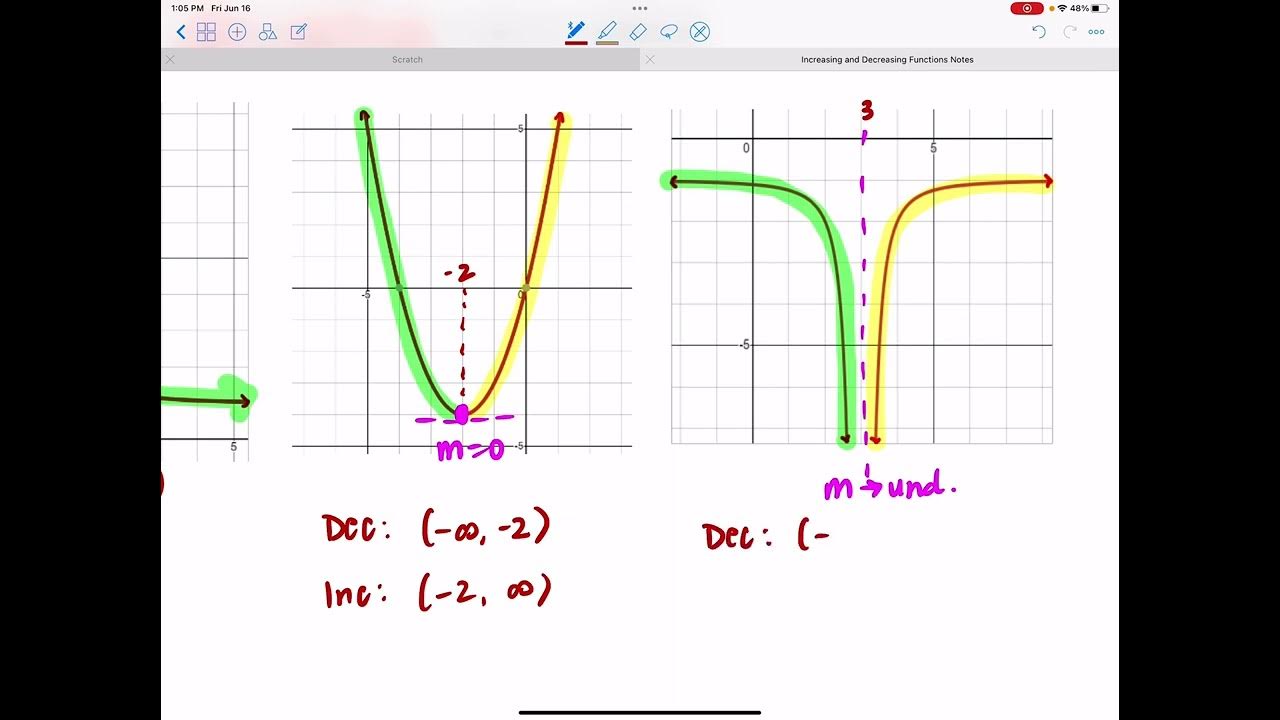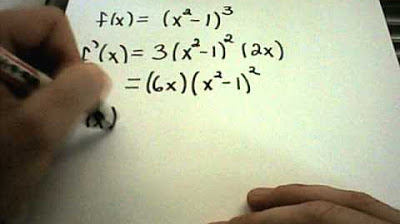Monotonicity Theorem
TLDRThe video script discusses the application of the monotonicity theorem to determine the intervals on which given functions are increasing or decreasing. The presenter simplifies the concept by relating it to the slope of a line from Algebra 1 and provides examples to illustrate how to find the derivative and use it to assess the function's behavior. The examples include a linear function and a more complex polynomial function, demonstrating how to find critical points and analyze intervals around them to determine monotonicity.
Takeaways
- 📈 The monotonicity theorem states that a function is increasing when its derivative is positive and decreasing when its derivative is negative.
- 🤓 The concept of monotonicity is intuitively understood as the direction of change in a function's value based on its slope.
- 👉 For the function f(x) = 3x + 3, the derivative f'(x) = 3, which is always positive, indicating the function is increasing for all values of x.
- 🔢 In Algebra 1, the slope of a line determines its increasing or decreasing nature, which is analogous to the derivative for functions.
- 📚 The second function H(z) = z^4 / 4 - z^3 / 6 has a derivative H'(z) = 3z^2 - 2z^3 that needs to be analyzed to determine intervals of increase and decrease.
- 🌟 By setting the derivative equal to zero, we can find critical points that help determine intervals of monotonicity.
- 🏆 Factoring the derivative H'(z) = z^2(3 - 2z) reveals that the function has critical points at z = 0 and z = 2.
- 📊 Testing values in intervals around the critical points shows that H'(z) is negative for z < 2 and positive for z > 2.
- 📈 The function H(z) is decreasing for z < 2 and increasing for z > 2, with a flat or constant interval at z = 2.
- 🎓 Understanding the monotonicity theorem and the concept of derivatives allows for the analysis of a function's increasing and decreasing behavior.
Q & A
What does the monotonicity theorem state?
-The monotonicity theorem states that a function is increasing when its derivative is greater than 0 and decreasing when its derivative is less than 0.
What is the derivative of the function f(x) = 3x + 3?
-The derivative of the function f(x) = 3x + 3 is f'(x) = 3, which is positive for all values of x, indicating that the function is increasing over its entire domain.
How can you determine the intervals where the function f(x) = 3x + 3 is increasing?
-Since the derivative f'(x) = 3 is positive for all x, the function f(x) = 3x + 3 is increasing over the interval from negative infinity to positive infinity.
What is the given function H(z) in the transcript?
-The given function H(z) in the transcript is H(z) = z^4/4 - 3z^3/2.
What is the derivative of H(z) = z^4/4 - 3z^3/2?
-The derivative of H(z) = z^4/4 - 3z^3/2 is H'(z) = 3z^3 - 6z^2.
How does the sign of the derivative of H(z) affect the monotonicity of the function?
-When the derivative H'(z) is positive, the function H(z) is increasing, and when H'(z) is negative, the function is decreasing.
What are the critical points of H'(z) = 0?
-The critical points of H'(z) = 0 are found by solving the equation z^3 - 2z^2 = 0, which gives z = 0 and z = 2.
In which intervals is H(z) increasing according to the transcript?
-According to the transcript, H(z) is increasing in the interval when z is greater than 2.
In which intervals is H(z) decreasing according to the transcript?
-According to the transcript, H(z) is decreasing in the interval when z is less than 2.
How does the speaker describe the graph of the derivative of H(z)?
-The speaker describes the graph of the derivative of H(z) as starting negative to the left of 0, going through 0 at z = 0, and then becoming negative again. It then increases and goes through a maximum point before finally becoming positive when z is greater than 2.
What is the significance of the monotonicity theorem in understanding the behavior of functions?
-The monotonicity theorem is significant because it provides a straightforward way to determine whether a function is increasing or decreasing based on the sign of its derivative, which helps in understanding the overall behavior of the function.
Outlines
📚 Introduction to Monotonicity Theorem
The speaker begins by addressing the audience and mentioning a request from a friend named Akosh to solve several problems. The speaker decides to tackle a few, acknowledging that covering all would result in an excessive number of videos. The main topic discussed is the Monotonicity Theorem, which is used to determine when a function is increasing or decreasing. The speaker humorously points out the formal language used to describe a fairly intuitive concept. The theorem states that if the derivative of a function is positive, the function is increasing, and if the derivative is negative, the function is decreasing. This is likened to the concept of slope from Algebra 1, where a positive slope indicates an increasing line, and a negative slope indicates a decreasing line. The speaker then moves on to discuss specific examples given by Akosh, starting with a linear function and then a more complex one.
📈 Analysis of Specific Functions
In this section, the speaker continues the discussion on the Monotonicity Theorem by analyzing specific functions provided in the examples. The first function is a simple linear function, f(x) = 3x + 3, and the speaker quickly determines that it is increasing for all values of x since its derivative, f'(x) = 3, is positive. The second function, H(z) = z^4 / 4 - z^3 / 6, is more complex. The speaker calculates its derivative, H'(z) = 3z^3 - 2z^2, and finds the critical points where the derivative is zero, which are z = 0 and z = 2. To determine the intervals where the function is increasing or decreasing, the speaker tests values below, between, and above the critical points. The speaker concludes that the function is decreasing for z < 2 and increasing for z > 2, based on the sign of the derivative. The speaker also reflects on the process and the interesting nature of the problem, noting that the function does not simply change from decreasing to increasing at the critical point but may have a more complex behavior. The video ends with the speaker indicating that there isn't enough time to tackle the next problem, which will be addressed in a future video.
Mindmap
Keywords
💡Monotonicity Theorem
💡Derivative
💡Slope
💡Increasing Function
💡Decreasing Function
💡Interval
💡Algebra
💡Graph
💡Critical Points
💡Test Points
💡Y-intercept
Highlights
The presenter begins by acknowledging a request from a user named Akosh to solve several math problems.
The presenter decides to skip some problems to avoid generating too many videos.
The presenter introduces the concept of the monotonicity theorem in a humorous and approachable way.
The monotonicity theorem is explained as a simple concept relating the derivative of a function to its increasing or decreasing nature.
The derivative is defined as the slope of a function, relating it to the concept learned in Algebra 1.
The presenter illustrates the monotonicity theorem with an example function, f(x) = 3x + 3, and explains that its derivative is positive for all values of x, indicating it is an increasing function.
The presenter uses a second, more complex function, H(z) = z^4 / 4 - z^3 / 6, to demonstrate how to find intervals of increase and decrease.
The derivative of the second function, H'(z) = 4z^3 / 4 - 3 * 2z^2 / 6, is calculated and simplified.
The presenter sets the derivative equal to zero to find critical points, solving for z and finding z = 0 and z = 2.
By testing values in intervals around the critical points, the presenter determines the function's behavior as increasing or decreasing.
The presenter concludes that the function H(z) is increasing for z > 2 and decreasing for z < 2, using the monotonicity theorem.
The presenter reflects on the interesting nature of the problem, noting the derivative's behavior around the critical points.
The presenter emphasizes the practical application of the monotonicity theorem in understanding the behavior of functions.
The presenter wraps up the session, indicating that the next problem will be addressed in a subsequent video.
Throughout the transcript, the presenter maintains an engaging and informative tone, making complex mathematical concepts accessible.
The transcript showcases the presenter's ability to break down and explain mathematical theorems in a way that is understandable to a wide audience.
Transcripts
Browse More Related Video

Increasing and Decreasing Functions

Analyzing concavity (algebraic) | AP Calculus AB | Khan Academy

Increasing/Decreasing + Local Max and Mins using First Derivative Test

Business Calculus - Math 1329 - Section 3.2 - Concavity and Points of Inflection

BusCalc 17 Critical Points

Increasing/decreasing functions [IB Maths AI SL/HL]
5.0 / 5 (0 votes)
Thanks for rating: